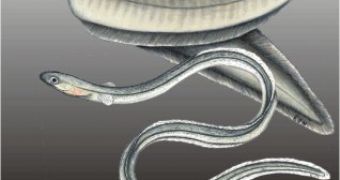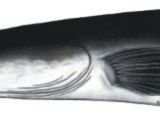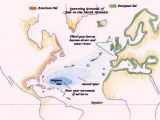Today, eel is one of the most popular fish in some world's cuisines, despite the strange snake like look. The oldest eel fossils are 100 million years old (from the time of dinosaurs) and were found in southern France and Lebanon, coming from Mesogea, the ancestral sea from which Mediterranean appeared and made a link between Atlantic and Pacific.
Two groups of eels formed from the ancestral species, Anguilla ancestralis: the 17 modern species from Indo-Pacific basin and 2 from Atlantic. All eels kept the same lifestyle: bred in marine warm sea waters at 400 m (1,330 ft) depths and grew in freshwater. The Anguilla atlantidis bred in the Sargasso Sea, in the young Atlantic Ocean, which was much smaller than today. The young reached by drifting Europe or North America, and this way resulted the North American (Anguilla rostrata) and European (Anguilla anguilla) eels, which differ only through the number of vertebrae (115 in the European species, 107 for the American species). The expansion of the Atlantic Ocean increased the distance, so the European eel had to make to Sargasso Sea to breed.
In the depths of the Sargasso Sea, the female eels spawn 1.3-1.5 million eggs, in water with temperatures over 17o C, and pressure 40 times higher than the atmospheric one. The incubation lasts 1-2 months. The larvae (leptocephali) are 6 mm long, translucent, look like willow leaves and feed on zooplankton. Gulf Stream transports them in 200 days across the Atlantic. The journey takes place during the day at 200-300 m (660-1,000 ft) depths and during the night at 25 m (83 ft) off the surface.
At 100 km (60 km) off Europe, the larvae turn into glass eels, which are 8 cm (3 in) long, weigh 0.3 grams, get snake form, and turn pigmented. The time of their arrival is October-March. They can form belts of millions of individuals, a few km long and 1m (3 ft) wide.
Most of them go upward into the rivers, turning into elvers, the stage till the eels are 20 cm (8 in) long. The European eel inhabits the rivers of Iceland, Europe (all that flow into the Atlantic and Mediterranean), Turkey, eastern coast of Levant, and northwestern Africa (the American eel enters rivers of eastern North America and Central America (from southern Greenland to Panama and Trinidad). At over 18 cm in length appear the scales, which are very small.
Eels consume one fourth of their weight daily and feed between 10-30o C, relying on their well developed olfaction. The food is made of dragonfly larvae, shrimps, water beetles, gobies, sticklebacks. Eels over 50 cm (1.6 ft) are called yellow eels, are nocturnal, and eat from mayfly larvae and worms, to fish (including other eels) or even small mammals, water birds.
Young eels advance with 40 km (25 mi) per month upward into the rivers. Females go upper into the rivers, and grow faster than the males. If eels find dams on the rivers, they eschew them through wet zones, crawling like snakes. In fact, eels can pull off the water for several meters and remain for a while in the ground, because the richly irrigated skin allows eels to breathe air.
During the day, eels stay buried in the sand, putting out just the head, to hide from predators. They are solitary and territorial. Males can reach a maximum of 45 cm (1.5 ft) and weigh 150 grams (0.3 pounds), while the females 80 cm (2.6 ft) and 1.5 kg (3.3 pounds), maximum 1.2 m (4 ft) and 5 kg (11 pounds).
In some rivers, eels make half of the fish mass. In western Europe, there can be 100-300 kg (220-660 pounds) of eels per hectare of river. The main predators of the eels (except humans) are cormorants, herons, otters. Drought or excessive freeze can be catastrophic for the eels.
For breeding, eels travel for 6 months into the Atlantic back to the Sargasso Sea, making 30 km (19 mi) daily. Eels go down into the sea during the fall, when they take advantage of the sea currents. For the breeding, eels accumulate fat reserves, the digestive tube gets atrophied and the anal orifice closes. The eyes get four times bigger for abyssal sight, and because of the pigment called guanine the body turns silvery (they are called silver eels). The pectoral fins get longer for the pelagic swimming. They reach the Sargasso Sea in March-April. The adults die after spawning. Males live 8-12 years, females 12-18 years, while in captivity they reached 85 years.
These are the eels consumed heavily by knowing consumers, but the other families of eels live exclusively in the sea. They form the Order Anguilliformes. All are more or less snake like shaped, have the unpaired fins (dorsal, caudal, and anal) united, and do not have pelvic fins.
The freshwater eels (Anguillidae) all live in rivers and breed in sea, differing just through distribution, the length of the dorsal fin, vertebrae number, skin color.
In the Indian Ocean, four species of freshwater eels breed. The African Anguilla mossambica and Anguilla nebulosa labiata breed in the abyssal fossa east of Madagascar, and grow in rivers from Madagascar and eastern Africa (from Kenya to Cap).
Anguilla nebulosa nebulosa grows in rivers in India, Ceylon, Sumatra, Java and northeastern Australia, while Anguilla bicolor, with a shorter dorsal fin, breeds in western Java.
In the Pacific 13, freshwater eel species reproduce because of the many breeding places.
Anguilla marmorata breeds off west New Guinea, and the larvae spreads to eastern Africa and Japan, being common in the waters of India to Tahiti and Society Islands.
Anguilla japonica is the only species of the area found in temperate waters, in Japan and China.
Four species breed in the Celebes Sea, colonizing inner waters of the islands between Sumatra and Borneo to Philippines and New Guinea: Anguilla ancestralis (believed to be the species from which all modern eels derived), A celebensis, A bicolor pacifica, and A borneensis.
Three species reproduce east of New Guinea, inhabiting inner waters of New Guinea (Anguilla interioris), Tahiti (Anguilla obscura), and Solomon Islands, Cook Islands and New Caledonia (Anguilla megastoma).
Four eel species breed in the southern seas. Anguilla australis australis and Anguilla reinhardtii breed in Fiji and inhabit the rivers of eastern Australia. The last is the largest freshwater eel: the females can be 1.8 m (6 ft) long and 18 kg (40 pounds) heavy.
In the New Zealand rivers, two species of eel live: Anguilla australis schmidti breeds in New Zealand, New Caledonia and Fiji, while Anguilla deiffenbachi in New Zealand.
Related to freshwater eels are the moray eels (Muraenidae). These eels, numerous in reefs, have large mouths with numerous teeth; often with fanglike (canine) teeth, and a second set of jaws in the back part of the mouth, an unique case amongst vertebrates. Moray eels like scales and pectoral fins. There are 15 genera and 200 species of moray eels. Murena helena, 1.5 m (5 ft) long, is common in Mediterranean (where another three genera exist).
Coger eels (Congridae) resemble best freshwater eels, but they live exclusively in the sea. The European conger goes to the depth of 1,000 m (3,300 ft), can be 2.5 m (8.3 ft) long and 60 kg (133 pounds).
The abyssal eels of the Saccopharyngiformes, with their enormous mouths, which can swallow fish the same size, are not true eels.

 14 DAY TRIAL //
14 DAY TRIAL // 

